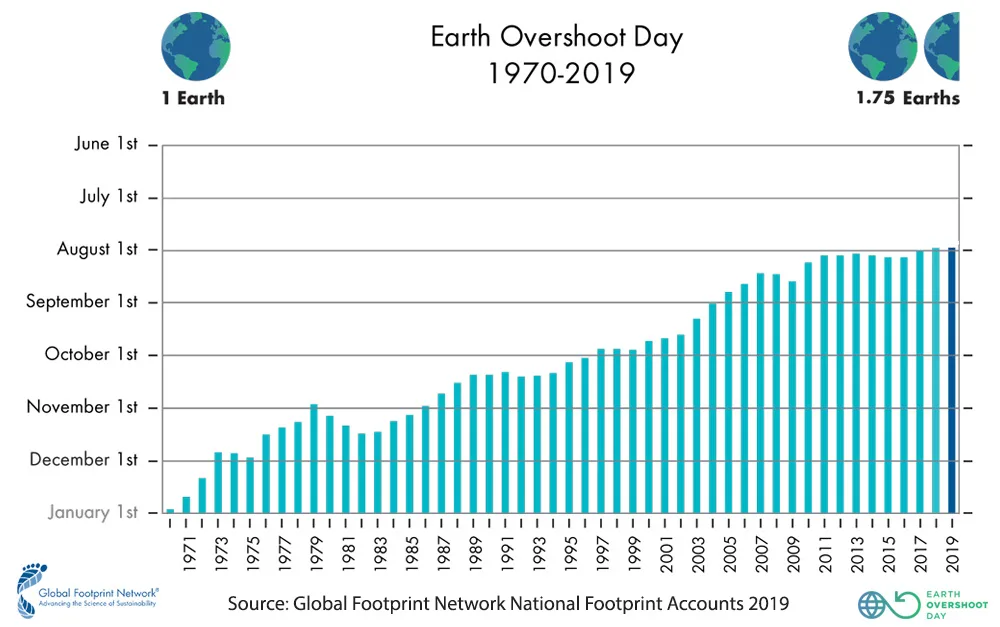
We're using up Earth's resources faster than ever before in 2019
We are now using up the resources of 1.75 Earths
Whether it is resources growing in the wild or renewed from what we'd used up from the year before, Earth's ecosystem is capable of growing only so much in one year - trees, plants, animals, fish, etc - to provide us with the resources we require.
In 2019, it has only taken six months and 29 days for us to run through all the resources Earth can offer us for the year!
That's the fastest so far, since we started keeping track in 1970.

Earth Overshoot Days, from 1970-2019, shows how we continue to tax Earth's resources, year by year. Credit: EarthOvershootDay.org
Unfortunately, this isn't a race, though.
Earth Overshoot Day is computed by dividing the amount of natural resources produced by Earth in one year, by the amount of resources consumed by human civilization in that year, and multiplying the result by 365 days.
According to the Global Footprint Network: "Earth Overshoot Day falling on July 29th means that humanity is currently using nature 1.75 times faster than our planet's ecosystems can regenerate. This is akin to using 1.75 Earths. Overshoot is possible because we are depleting our natural capital - which compromises humanity's future resource security. The costs of this global ecological overspending are becoming increasingly evident in the form of deforestation, soil erosion, biodiversity loss, or the buildup of carbon dioxide in the atmosphere. The latter leads to climate change and more frequent extreme weather events."
"We have only got one Earth - this is the ultimately defining context for human existence," said Mathis Wackernagel, the founder of Global Footprint Network, who co-invented the accounting used to compute Ecological Footprint. "We can't use 1.75 without destructive consequences."
With a growing global population, expected to reach 9.8 billion by 2050, it's difficult to see how we can sustain this. By just moving the date of Earth Overshoot Day back by 5 days each year, however, we can put ourselves back at only consuming one planet's worth of resources by that same year!
The Global Footprint Network says that cutting CO2 emissions by half of what they are now can move Earth Overshoot Day by a total of 93 days. That, alone, would push it to October 30, or what it was in 1986!
"With Earth Overshoot Day occurring ever earlier in the year, and a big part of it being the growing amounts of CO2 emissions, the importance of decisive action is becoming ever more evident," said María Carolina Schmidt Zaldívar, Chile's Minister of Environment and the chair of the upcoming Climate COP25 meeting in December. "For this reason, we are working with all parties to find effective approaches."
Want to know your personal Overshoot Day?
CANADA AMONG WORSE CONSUMERS
Different nations around the world consume resources at different rates, of course. It's only when you add up everyone's contributions, that we reach one Earth Overshoot Day for the entire planet.
Canada has abundant resources, and we may see ourselves as reasonably responsible consumers, but unfortunately, on average, that's just not the case.
If the entire world consumed at the same rate as the average Canadian, it wouldn't have taken us less than 7 months to reach Earth Overshoot Day 2019. We would have used up Earth's entire 2019 supply of resources by March 18.

This graphic plots Earth Overshoot Day based on the consumption practices of the average citizen of nations around the world. Look to the top right of the graphic to find both Canada and the United States, with Earth Overshoot Days in mid-March. Credit: Global Footprint Network
One positive bit of news here: Canada's Earth Overshoot Day didn't budge from 2018 to 2019.
WE CAN #MOVETHEDATE
As seen in the Earth Overshoot Day 1969-2019 graph, above, the date of Earth Overshoot Day doesn't necessarily keep falling earlier on the calendar, year to year. Some years, it actually advances by one or more days, due to short-term shifts in consumer patterns, pollution emissions, and the response of nature to weather and climate change. Also, the date has been holding at least reasonably steady since 2010.
There are also ways that we can consciously move the date farther along the calendar, and the Global Footprint Network names four key solutions to this resource problem:
Cities: If we reduce driving by 50% around the world and replace one-third of car miles with public transportation and the rest by walking and biking, we can #MoveTheDate of Overshoot Day back 12 days.
Energy: Reducing the carbon component of humanity’s Ecological Footprint by 50% would #MoveTheDate 93 days.
Food: If everyone in the world cut food waste in half, reduced the Footprint intensity of their diets, and consumed world-average calories, we would #MoveTheDate 38 days.
Population: If every other family in the world had one less child, we would move Overshoot Day 30 days by 2050.
For more information, check out the Earth Overshoot Day website and follow the hashtag #MoveTheDate on social media.
Sources: Earth Overshoot Day | With files from The Weather Network











